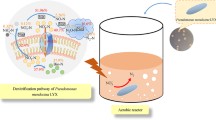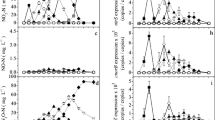Abstract
Excess amount of nitrogen in wastewater has caused serious concerns, such as water eutrophication. Paracoccus pantotrophus MA3, a novel isolated strain of heterotrophic nitrification–anaerobic denitrification bacteria, was evaluated for nitrogen removal using formic acid as the sole carbon source. The results showed that the maximum ammonium removal efficiency was observed under the optimum conditions of 26.25 carbon to nitrogen ratio, 3.39% (v/v) inoculation amount, 34.64 °C temperature, and at 180 rpm shaking speed, respectively. In addition, quantitative real-time PCR technique analysis assured that the gene expression level of formate dehydrogenase, formate tetrahydrofolate ligase, 5,10-methylenetetrahydrofolate dehydrogenase, serine hydroxymethyltransferase, respiratory nitrate reductase beta subunit, L-glutamine synthetase, glutamate dehydrogenase, and glutamate synthase were up-regulated compared to the control group, and combined with nitrogen mass balance analysis to conclude that most of the ammonium was removed by assimilation. A small amount of nitrate and nearly no nitrite were accumulated during heterotrophic nitrification. MA3 exhibited significant denitrification potential under anaerobic conditions with a maximum nitrate removal rate of 4.39 mg/L/h, and the only gas produced was N2. Additionally, 11.50 ± 0.06 mg/L/h of NH4+-N removal rate from biogas slurry was achieved.






Similar content being viewed by others
References
Alengebawy A, Jin K, Ran Y, Peng J, Zhang X, Ai P (2021) Advanced pre-treatment of stripped biogas slurry by polyaluminum chloride coagulation and biochar adsorption coupled with ceramic membrane filtration. Chemosphere 267:129197. https://doi.org/10.1016/j.chemosphere.2020.129197
Ni H, Arslan M, Wei J, Dai J, Luo Z, Cai R, Zhao S, Gamal El-Din M, Wu Z (2021) Treatment of printing and dyeing wastewater in biological contact oxidation reactors comprising basalt fibers and combination fillers as bio-carriers: Elucidation of bacterial communities and underlying mechanisms. Sci Total Environ 785:147272. https://doi.org/10.1016/j.scitotenv.2021.147272
Qu D, Wang C, Wang Y, Zhou R, Ren H (2015) Heterotrophic nitrification and aerobic denitrification by a novel groundwater origin cold-adapted bacterium at low temperatures. RSC Adv 5(7):5149–5157. https://doi.org/10.1039/C4RA13141J
Li Y, Chapman SJ, Nicol GW, Yao H (2018) Nitrification and nitrifiers in acidic soils. Soil Biol Biochem 116:290–301. https://doi.org/10.1016/j.soilbio.2017.10.023
Chen Z, Jiang Y, Chang Z, Wang J, Song X, Huang Z, Chen S, Li J (2020) Denitrification characteristics and pathways of a facultative anaerobic denitrifying strain, Pseudomonas denitrificans G1. J Biosci Bioeng 129(6):715–722. https://doi.org/10.1016/j.jbiosc.2019.12.011
Liu Y, Shi H, Xia L, Shi H, Shen T, Wang Z, Wang G, Wang Y (2010) Study of operational conditions of simultaneous nitrification and denitrification in a Carrousel oxidation ditch for domestic wastewater treatment. Biores Technol 101(3):901–906. https://doi.org/10.1016/j.biortech.2009.09.015
Cui Y, Cui YW, Huang JL (2021) A novel halophilic Exiguobacterium mexicanum strain removes nitrogen from saline wastewater via heterotrophic nitrification and aerobic denitrification. Biores Technol 333:125189. https://doi.org/10.1016/j.biortech.2021.125189
Medhi K, Singhal A, Chauhan DK, Thakur IS (2017) Investigating the nitrification and denitrification kinetics under aerobic and anaerobic conditions by Paracoccus denitrificans ISTOD1. Biores Technol 242:334–343. https://doi.org/10.1016/j.biortech.2017.03.084
Fang J, Liao S, Zhang S, Li L, Tan S, Li W, Wang A, Ye J (2021) Characteristics of a novel heterotrophic nitrification-aerobic denitrification yeast, Barnettozyma californica K1. Biores Technol 339:125665. https://doi.org/10.1016/j.biortech.2021.125665
Yang L, Wang XH, Cui S, Ren YX, Yu J, Chen N, Xiao Q, Guo LK, Wang RH (2019) Simultaneous removal of nitrogen and phosphorous by heterotrophic nitrification-aerobic denitrification of a metal resistant bacterium Pseudomonas putida strain NP5. Biores Technol 285:121360. https://doi.org/10.1016/j.biortech.2019.121360
Zhang J, Wu P, Hao B, Yu Z (2011) Heterotrophic nitrification and aerobic denitrification by the bacterium Pseudomonas stutzeri YZN-001. Biores Technol 102(21):9866–9869. https://doi.org/10.1016/j.biortech.2011.07.118
Huang F, Pan L, Lv N, Tang X (2017) Characterization of novel Bacillus strain N31 from mariculture water capable of halophilic heterotrophic nitrification–aerobic denitrification. J Biosci Bioeng 124(5):564–571. https://doi.org/10.1016/j.jbiosc.2017.06.008
Rout PR, Bhunia P, Dash RR (2017) Simultaneous removal of nitrogen and phosphorous from domestic wastewater using Bacillus cereus GS-5 strain exhibiting heterotrophic nitrification, aerobic denitrification and denitrifying phosphorous removal. Biores Technol 244:484–495. https://doi.org/10.1016/j.biortech.2017.07.186
Chen H, Zhou W, Zhu S, Liu F, Qin L, Xu C, Wang Z (2021) Biological nitrogen and phosphorus removal by a phosphorus-accumulating bacteria Acinetobacter sp. strain C-13 with the ability of heterotrophic nitrification–aerobic denitrification. Bioresour Technol 322:124507. https://doi.org/10.1016/j.biortech.2020.124507
Yang JR, Wang Y, Chen H, Lyu YK (2019) Ammonium removal characteristics of an acid-resistant bacterium Acinetobacter sp JR1 from pharmaceutical wastewater capable of heterotrophic nitrification-aerobic denitrification. Bioresour Technol 274:56–64. https://doi.org/10.1016/j.biortech.2018.10.052
Aboobakar A, Cartmell E, Stephenson T, Jones M, Vale P, Dotro G (2013) Nitrous oxide emissions and dissolved oxygen profiling in a full-scale nitrifying activated sludge treatment plant. Water Res 47(2):524–534. https://doi.org/10.1016/j.watres.2012.10.004
Zhang QL, Liu Y, Ai GM, Miao LL, Zheng HY, Liu ZP (2012) The characteristics of a novel heterotrophic nitrification–aerobic denitrification bacterium, Bacillus methylotrophicus strain L7. Biores Technol 108:35–44. https://doi.org/10.1016/j.biortech.2011.12.139
Kweku DW, Bismark O, Maxwell A, Desmond KA, Danso KB, Oti-Mensah EA, Quachie AT, Adormaa BB (2017) Greenhouse effect: greenhouse gases and their impact on global warming. J Sci Res Rep 17(6):1–9. https://doi.org/10.9734/JSRR/2017/39630
Takaya N, Catalan-Sakairi MAB, Sakaguchi Y, Kato I, Zhou Z, Shoun H (2003) Aerobic denitrifying bacteria that produce low levels of nitrous oxide. Appl Environ Microbiol 69(6):3152–3157. https://doi.org/10.1128/AEM.69.6.3152-3157.2003
Hong P, Shu Y, Wu X, Wang C, Tian C, Wu H, Donde OO, Xiao B (2019) Efficacy of zero nitrous oxide emitting aerobic denitrifying bacterium, Methylobacterium gregans DC-1 in nitrate removal with strong auto-aggregation property. Biores Technol 293:122083. https://doi.org/10.1016/j.biortech.2019.122083
Kortlever R, Peters I, Koper S, Koper MTM (2015) Electrochemical CO2 reduction to formic acid at low overpotential and with high faradaic efficiency on carbon-supported bimetallic Pd–Pt nanoparticles. ACS Catal 5(7):3916–3923. https://doi.org/10.1021/acscatal.5b00602
Liu Q, Yang X, Li L, Miao S, Li Y, Li Y, Wang X, Huang Y, Zhang T (2017) Direct catalytic hydrogenation of CO2 to formate over a Schiff-base-mediated gold nanocatalyst. Nat Commun 8(1):1407. https://doi.org/10.1038/s41467-017-01673-3
Liesivuori J (1991) Savolainen, heikki, methanol and formic acid toxicity: biochemical mechanisms. Pharmacol Toxicol 69(3):157–163. https://doi.org/10.1111/j.1600-0773.1991.tb01290.x
Naik RB, Stephens WP, Wilson DJ, Walker A, Lee HA (1980) Ingestion of formic acid-containing agents–report of three fatal cases. Postgrad Med J 56(656):451. https://doi.org/10.1136/pgmj.56.656.451
Villa Rodríguez E, Ibarra Gámez C, de los Santos-Villalobos S (2018) Extraction of high-quality RNA from Bacillus subtilis with a lysozyme pre-treatment followed by the Trizol method. J Microbiol Methods 147:14–16. https://doi.org/10.1016/j.mimet.2018.02.011
Xu N, Liao M, Liang Y, Guo J, Zhang Y, Xie X, Fan Q, Zhu Y (2021) Biological nitrogen removal capability and pathways analysis of a novel low C/N ratio heterotrophic nitrifying and aerobic denitrifying bacterium (Bacillus thuringiensis strain WXN-23). Environ Res 195:110797. https://doi.org/10.1016/j.envres.2021.110797
Livak KJ, Schmittgen TD (2001) Analysis of relative gene expression data using real-time quantitative PCR and the 2−ΔΔCT method. Methods 25(4):402–408. https://doi.org/10.1006/meth.2001.1262
Meng F, Yang A, Zhang G, Li J, Zou Z, Zhang Y (2019) Effects of C/N ratio on pollution removal efficiency and cell proliferation during the bioconversion of wastewater by photosynthetic bacteria. Desalin Water Treat 156:68–77. https://doi.org/10.5004/dwt.2019.24093
Li C, Yang J, Wang X, Wang E, Li B, He R, Yuan H (2015) Removal of nitrogen by heterotrophic nitrification–aerobic denitrification of a phosphate accumulating bacterium Pseudomonas stutzeri YG-24. Biores Technol 182:18–25. https://doi.org/10.1016/j.biortech.2015.01.100
Zhang D, Li W, Huang X, Qin W, Liu M (2013) Removal of ammonium in surface water at low temperature by a newly isolated Microbacterium sp. strain SFA13. Bioresour Technol 137:147–152. https://doi.org/10.1016/j.biortech.2013.03.094
Xia L, Li X, Fan W, Wang J (2020) Heterotrophic nitrification and aerobic denitrification by a novel Acinetobacter sp. ND7 isolated from municipal activated sludge. Bioresour Technol 301:122749. https://doi.org/10.1016/j.biortech.2020.122749
Zhang N, Chen H, Lyu Y, Wang Y (2018) Nitrogen removal by a metal-resistant bacterium, Pseudomonas putida ZN1, capable of heterotrophic nitrification–aerobic denitrification. J Chem Technol Biotechnol 94(4):1165–1175. https://doi.org/10.1002/jctb.5863
Ladd JN, Jackson RB (1982) Biochemistry of ammonification. Nitrogen Agric Soils. https://doi.org/10.2134/agronmonogr22.c5
Yang Q, Yang T, Shi Y, Xin Y, Zhang L, Gu Z, Li Y, Ding Z, Shi G (2021) The nitrogen removal characterization of a cold-adapted bacterium: Bacillus simplex H-b. Biores Technol 323:124554. https://doi.org/10.1016/j.biortech.2020.124554
Zhao B, He YL, Zhang XF (2010) Nitrogen removal capability through simultaneous heterotrophic nitrification and aerobic denitrification by Bacillus sp. LY, Environ Technol 31(4):409–416. https://doi.org/10.1080/09593330903508922
Huang X, Li W, Zhang D, Qin W (2013) Ammonium removal by a novel oligotrophic Acinetobacter sp. Y16 capable of heterotrophic nitrification–aerobic denitrification at low temperature. Bioresour Technol 146:44–50. https://doi.org/10.1016/j.biortech.2013.07.046
Jin P, Chen Y, Yao R, Zheng Z, Du Q (2019) New insight into the nitrogen metabolism of simultaneous heterotrophic nitrification-aerobic denitrification bacterium in mRNA expression. J Hazard Mater 371:295–303. https://doi.org/10.1016/j.jhazmat.2019.03.023
Baumann B, Snozzi M, Zehnder AJ, Van Der Meer JR (1996) Dynamics of denitrification activity of Paracoccus denitrificans in continuous culture during aerobic-anaerobic changes. J Bacteriol 178(15):4367–4374. https://doi.org/10.1128/jb.178.15.4367-4374.1996
Van Spanning RJM, de Boer APN, Reijnders WNM, De Gier JWL, Delorme CO, Stouthamer AH, Westerhoff HV, Harms N, van der Oost J (1995) Regulation of oxidative phosphorylation: the flexible respiratory network of Paracoccus denitrificans. J Bioenerg Biomembr 27(5):499–512. https://doi.org/10.1007/BF02110190
Wimpenny JWT, Cole JA (1967) The regulation of metabolism in facultative bacteria III. The effect of nitrate, Biochimica et Biophysica Acta (BBA) - General Subjects 148(1):233–242. https://doi.org/10.1016/0304-4165(67)90298-X
Li B, Jing F, Wu D, Xiao B, Hu Z (2021) Simultaneous removal of nitrogen and phosphorus by a novel aerobic denitrifying phosphorus-accumulating bacterium, Pseudomonas stutzeri ADP-19. Biores Technol 321:124445. https://doi.org/10.1016/j.biortech.2020.124445
Su JF, Cheng C, Ma F (2017) Comparison of the NH4+-N removal ability by Klebsiella sp. FC61 in a bacterial suspension system and a bacterial immobilization system. Sep Purif Technol 172:463–472. https://doi.org/10.1016/j.seppur.2016.09.002
Bar Even A, Noor E, Flamholz A, Milo R (2013) Design and analysis of metabolic pathways supporting formatotrophic growth for electricity-dependent cultivation of microbes. Biochimica et Biophysica Acta (BBA) - Bioenergetics 1827(8):1039–1047. https://doi.org/10.1016/j.bbabio.2012.10.013
Cáceres R, Malińska K, Marfà O (2018) Nitrification within composting: a review. Waste Manage 72:119–137. https://doi.org/10.1016/j.wasman.2017.10.049
Nagatani H, Shimizu M, Valentine RC (1971) The mechanism of ammonia assimilation in nitrogen fixing bacteria. Arch Mikrobiol 79(2):164–175. https://doi.org/10.1007/BF00424923
Jiang HW, Chen Q, Pan J, Zheng GW, Xu JH (2020) Rational engineering of formate dehydrogenase substrate/cofactor affinity for better performance in NADPH regeneration. Appl Biochem Biotechnol 192(2):530–543. https://doi.org/10.1007/s12010-020-03317-7
Qing H, Donde OO, Tian C, Wang C, Wu X, Feng S, Liu Y, Xiao B (2018) Novel heterotrophic nitrogen removal and assimilation characteristic of the newly isolated bacterium Pseudomonas stutzeri AD-1. J Biosci Bioeng 126(3):339–345. https://doi.org/10.1016/j.jbiosc.2018.03.010
He X, Sun Q, Xu T, Dai M, Wei D (2019) Removal of nitrogen by heterotrophic nitrification–aerobic denitrification of a novel halotolerant bacterium Pseudomonas mendocina TJPU04. Bioprocess Biosyst Eng 42(5):853–866. https://doi.org/10.1007/s00449-019-02088-8
Yang A, Zhang G, Yang G, Wang H, Meng F, Wang H, Peng M (2017) Denitrification of aging biogas slurry from livestock farm by photosynthetic bacteria. Biores Technol 232:408–411. https://doi.org/10.1016/j.biortech.2017.01.073
Acknowledgements
This work was supported by the National Key R&D Programs of China (2018YFA090048), the National Natural Science Foundation Program of China (No. 31972611), and the Central Universities Fundamental Research Funds (No. 2662020GXPY006). The authors would like to thank Dr. Nirmal Ghimire for his help in the revision process.
Author information
Authors and Affiliations
Corresponding authors
Ethics declarations
Conflict of interest
The authors declare that they have no conflict of interest.
Additional information
Publisher's Note
Springer Nature remains neutral with regard to jurisdictional claims in published maps and institutional affiliations.
Supplementary Information
Below is the link to the electronic supplementary material.
Rights and permissions
Springer Nature or its licensor holds exclusive rights to this article under a publishing agreement with the author(s) or other rightsholder(s); author self-archiving of the accepted manuscript version of this article is solely governed by the terms of such publishing agreement and applicable law.
About this article
Cite this article
Huang, Q., Alengebawy, A., Zhu, X. et al. Performance of Paracoccus pantotrophus MA3 in heterotrophic nitrification–anaerobic denitrification using formic acid as a carbon source. Bioprocess Biosyst Eng 45, 1661–1672 (2022). https://doi.org/10.1007/s00449-022-02771-3
Received:
Accepted:
Published:
Issue Date:
DOI: https://doi.org/10.1007/s00449-022-02771-3




